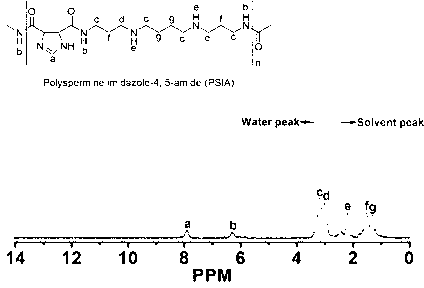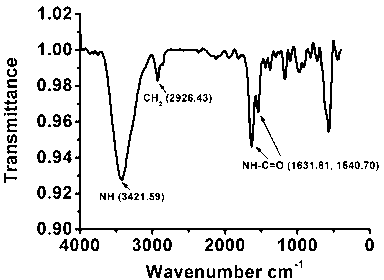Poly spermine cations, construction method thereof, and preparation method of nano-grade particles
A nanoparticle and construction method technology, applied in the field of degradable amide polyspermine cations and its construction, can solve the problems of slow degradation rate, affecting nucleic acid delivery efficiency, and reduced transfection efficiency
- Summary
- Abstract
- Description
- Claims
- Application Information
AI Technical Summary
Problems solved by technology
Method used
Image
Examples
Embodiment 1
[0042] Example 1. Construction of Polyspermine Cationic PSIA
[0043] figure 1 It is a schematic diagram of the synthetic route of polyspermine cationic PSIA. The whole reaction was carried out in an anhydrous and oxygen-free environment. Weigh 100mg imidazole-4,5-dicarboxylic acid, 528mg dicyclohexylcarbodiimide, 295mg N-hydroxysuccinimide and 1mL trifluoroacetic acid and dissolved in 5mL N, In the N-dimethylformamide solution, stir at room temperature for 12 hours; then, weigh 130 mg of spermine and dissolve it in 5 mL of the N,N-dimethylformamide solution at -10~10°C (preferably 0°C), The above carboxyl activated imidazole-4,5-dicarboxylic acid was slowly added dropwise to the above spermine solution, and the reaction was stirred for 24 hours at room temperature. Vacuum filtration, evaporate the solvent, and re-dissolve the reaction solution residue in ultrapure water, dialyze for 12 to 48 hours, pre-freeze at -80 degrees for 4 hours, and then freeze-dry to obtain polyspermin...
Embodiment 2
[0045] Example 2. Preparation of PSIA and pDNA nanoparticles
[0046] Weigh a certain amount of polyspermine cation PSIA and dissolve it in water to a concentration of 2.0mg / ml, filter it through a 0.45μm water membrane for use; draw a certain amount of pDNA solution and dilute with water to a 20μg / ml pDNA stock solution. When preparing PSIA and pDNA nanoparticles, dilute the PSIA solution to the corresponding concentration according to the set mass ratio of a series of PSIA and pDNA, and then quickly add it to the pDNA solution of the same volume and fixed concentration, so that the final concentration of pDNA is 2μg / ml, finally gently pipetting, mixing uniformly, and incubating at room temperature for 20-30 minutes to obtain a series of nanoparticle solutions with different mass ratios of PSIA and pDNA for further physical and chemical characterization.
Embodiment 3
[0047] Example 3. Agarose gel electrophoresis of PSIA and pDNA nanoparticles
[0048] Weigh 1.0g agarose, add 100ml 1×TAE buffer solution, heat it in a microwave oven to dissolve it, wait until the temperature drops to 65℃, add ethidium bromide (EB) to make 1.0% agarose solution (containing 0.5μg / ml Ethidium bromide), pour it into the glue making tank, insert the sample comb, and leave it at room temperature for 0.5-1 hour until the glue solidifies. Then, pull out the sample comb, add TAE buffer to the electrophoresis tank to cover the gel, and wait for the sample to be loaded. Next, prepare nanoparticle solutions with different mass ratios according to the preparation method of nanoparticles. The mass ratios of PSIA and pDNA in the nanoparticle solution are 0, 1, 2, 3, 5, 7, 10, 15, 20, 30, 50, 70, 100. Marker chooses DS TM 5000 (100-5000bp), loading 2μl; 6x loading buffer (bromophenol blue-glycerin indicator, containing 0.25% bromophenol blue, 40% glycerol) 1μl and nanopart...
PUM
| Property | Measurement | Unit |
|---|---|---|
| particle diameter | aaaaa | aaaaa |
| molecular weight | aaaaa | aaaaa |
| particle size | aaaaa | aaaaa |
Abstract
Description
Claims
Application Information
 Login to View More
Login to View More - R&D
- Intellectual Property
- Life Sciences
- Materials
- Tech Scout
- Unparalleled Data Quality
- Higher Quality Content
- 60% Fewer Hallucinations
Browse by: Latest US Patents, China's latest patents, Technical Efficacy Thesaurus, Application Domain, Technology Topic, Popular Technical Reports.
© 2025 PatSnap. All rights reserved.Legal|Privacy policy|Modern Slavery Act Transparency Statement|Sitemap|About US| Contact US: help@patsnap.com



